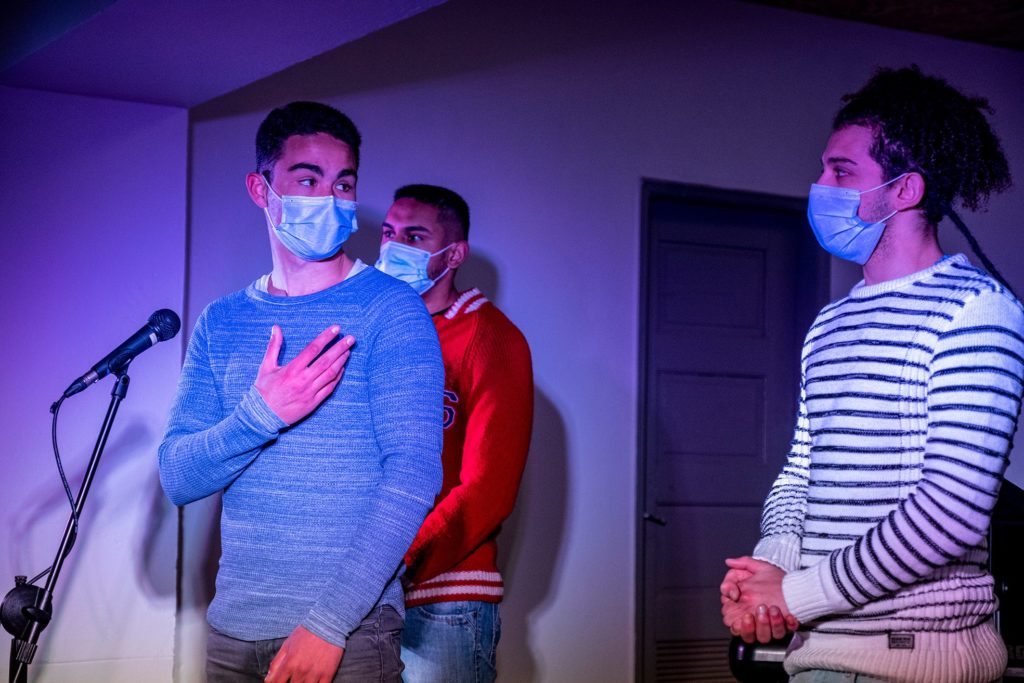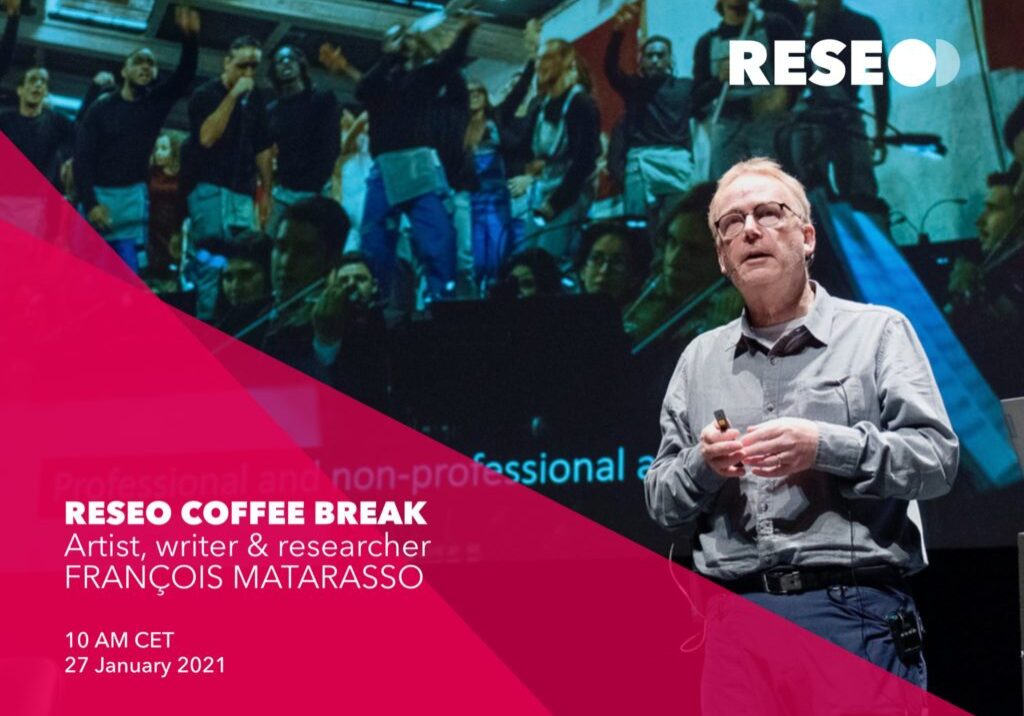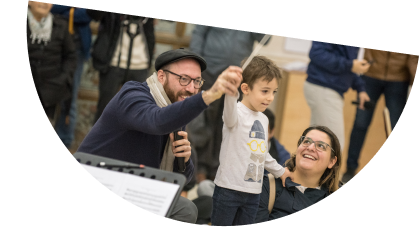In conversation with François Matarasso
Last month, RESEO steering committee member James Bingham (Irish National Opera) sat down with the community artist, writer and consultant François Matarasso to discuss participatory art, co-creation and the European project Traction.
So often in the arts sector, it is easy for us to isolate communities with terminology that confuses more than it explains. One of François Matarasso’s strengths is turning daunting language into something far more approachable, which is vital in meaningful community work.
“I wanted to try and make our work simpler and more understandable to people. I ended up settling on the term participatory art, to embrace all of that work in all its diversity,” he said, “My belief is that an artist is somebody who does a special kind of thing, not a special kind of person. Anyone who’s making art is an artist, in the same way that anybody who’s cooking a meal is a cook.”
Matarasso’s most recent publication ‘A Restless Art: How Participation Won, and Why It Matters’ explores these ideas in the form of a plain English guide to the principles of participatory art. Alongside looking at good practice in the field, the book explores the origins of why there has been a need for participatory art.
“The origins of this split, between two kinds of artistic practice, lie in the Enlightenment and the invention of this thing called Fine Art. As soon as you invent Fine Art, you automatically invent ‘not-Fine Art’,” François explained “The Enlightenment Fine Art project was really powerful because it emancipated the creation of art and, by extension, the creation of values from church and state from those two big pre-Enlightenment centres of power and value. The invention of Fine Art gave us 200 years of a kind of turbocharged artistic practice in the rich countries of western Europe.”
“I was always interested in social change”
We also discussed François’ background and how exactly he got into the world of participatory art and the research surrounding it. “I stumbled into community art. It was by chance of going to a community print shop to get some posters printed. In answer to the question, ‘can you print this poster for me?’ I was told ‘no, but we can show you how to print it yourself’, and that was how I started learning about community art.”
“I think I was always interested in social change. I probably would have gravitated maybe to community development work or something like that, but it happens that my abilities and understanding such as they are better deployed in art. The research came from the combination of funders asking more and more difficult questions, particularly because by the late 80s, I was mostly doing work that wasn’t funded by Arts Councils. It was being funded by social services or education and they were asking us to explain what the value of it was.”
The question of the purpose of participatory art also came up. “For me, the purpose of the work starts with article 27 of the Universal Declaration of Human Rights, which says that everyone has the right to participate in the cultural life of the community and to enjoy the arts. Art and culture is how societies and individuals construct values, define what’s meaningful to them, say what they believe in, what they don’t believe in, what they admire and what they reject. I think that it is integral to being a human being, that you are able to form and share your cultural values.”
Towards a definition of participatory art
Based on these definitions, we looked at the more cynical end of the spectrum. Could TV talent shows, which see professionals work with non-professionals, technically be classed as participatory art? That in turn led into issues around ethics and power.
“I think what you’re describing is participatory art, but maybe bad participatory art. As with anything human beings do, there’s good, bad and an awful lot of average. One of the reasons I called the book ‘A Restless Art’ is because there’s always a degree of dynamic tension in this work. As soon as you bring professional and non-professional artists together, you are bringing people with very different levels of power to work together, so problems arise all the time. Sometimes people think that you just have to solve the ethical problems, and then you can get on with the work. Actually, it’s in solving the ethical problems that you do the work, and that is the value of it.”
Opera for social inclusion through community engagement and co-creation

We then went on to talk about François’ work on the European project Traction: “Traction is a research project. I think that’s the first important distinction because it’s funded by the European Commission, but under the Horizon 2020 programme which is a research and innovation programme,” François explained, “In the arts people are used to projects being funded through Creative Europe, which is a programme for artistic production and exchange. Traction being a research programme gives it a very different character. It is trying to answer questions about whether opera can be a route for social inclusion through community engagement and co-creation processes and whether new digital technology can support that process of co-creation. So the big question is how can community opera contribute to social inclusion? And secondarily, what role can technology play in that?”
Traction is a partnership that involves research institutes in the Netherlands, Ireland, and Spain alongside two opera companies: Irish National Opera and the Liceu Opera House in Barcelona, and a music school in Portugal, called SAMP. It involves universities in Barcelona and in Dublin alongside François himself.
Avoiding the trap of social hierarchies in participatory opera
Matarasso is relatively new to opera. With this fresh perspective, we discussed challenges unique to the art form when working in a participatory context:
“Because of the technical demands of singing opera, there is a danger that community operas end up with professional soloist and non-professional choruses. In doing that, they artistically embed the social hierarchy that they are trying to overcome. That’s a trap and it’s hard to solve. One of the one of the best ways I think it was solved was with the performance of the Bach, St. Matthew Passion by Streetwise Opera and The Sixteen. They had thought about how you blend the voices of non-professional people with experience of homelessness with the voices of one of the world’s leading choirs without making something that doesn’t sound good. One part of the answer they came up with was to say that the members of Streetwise Opera will sing the role of Jesus. When the Pharisees (sung by the Sixteen) are singing with all of their technical ability, they’re almost singing down, shouting down the fragile voice of Jesus, and it’s spine chilling. I think that was a very clever way of managing that.”
We finished with a question about spending priorities: If Matarasso was able to decide where to allocate funding across the next ten years, what would he do?
“I will do what I was able to do once before, which is I will give the money to the communities to spend as they see fit. I worked on a programme in Southeast Europe on living heritage from the late 90s to about 2005. The critical thing we did was to give communities small amounts of money to do the projects that they wanted to do. At the beginning of the project when people were asking me, what do you mean by heritage? I would say it could be traditional dance, it could be a museum, it could be natural heritage. After a couple of years of learning and working on this programme, I changed what I was saying to people and said heritage is whatever people care about. It’s the caring that matters. If I could really make a difference to the art funding system, it would be to empower communities to make their own choices. I don’t think they would make any worse choices than those that are made on their behalf.”
You can read ‘A Restless Art’ for free at François Matarasso’s website, where he also regularly blogs, and view our full conversation here.


